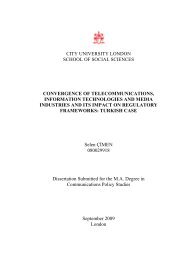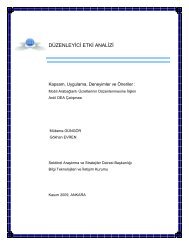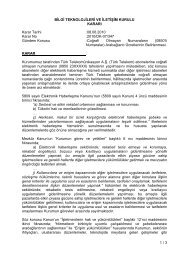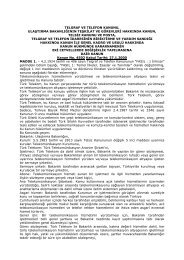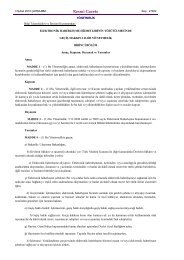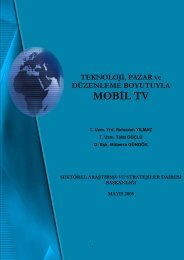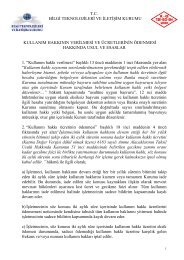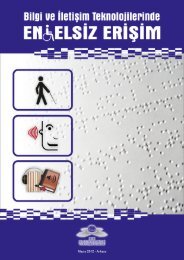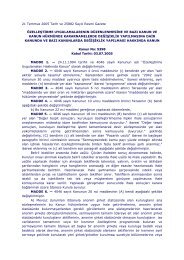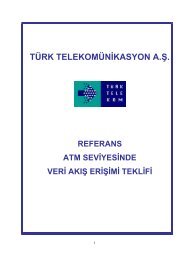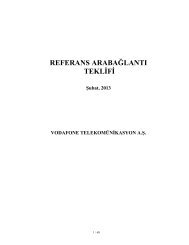MAXIMISING THE OPPORTUNITY OF THE DIGITAL DIVIDEND ...
MAXIMISING THE OPPORTUNITY OF THE DIGITAL DIVIDEND ...
MAXIMISING THE OPPORTUNITY OF THE DIGITAL DIVIDEND ...
Create successful ePaper yourself
Turn your PDF publications into a flip-book with our unique Google optimized e-Paper software.
8th International Electronic CommunicationsRegulators ConferenceIstanbul, Turkey - May 2013<strong>MAXIMISING</strong> <strong>THE</strong> <strong>OPPORTUNITY</strong> <strong>OF</strong><strong>THE</strong> <strong>DIGITAL</strong> <strong>DIVIDEND</strong>Development and harmonisation ofspectrum policy to achieve broadbandconnectivityPeter LyonsDirector of Public PolicyGSM Association
About GSMA• Representing the interests of theworldwide mobile communicationsindustry. Nearly 800 operatormembers covering over 200countries.• More than 200 associate membersfrom the broader mobile ecosystem,including handset makers, softwarecompanies, equipment providers,Internet companies, and media andentertainment organizations.www.gsma.com
Agenda• International regulatory framework of the Digital Dividend• The importance of harmonisation• Summary
Regulatory Framework of the Digital Dividend• The historical spectrum allocation for analogue televisionAnalogue broadcasting470 MHz 862 MHz• In 2006, the Geneva 06 Agreement (GE-06) planned the migration from analogueto digital TV broadcasting for Europe, the Middle East and Africa, with theanalogue switch-off (ASO) deadline set for June 2015.Digital broadcasting470 MHz 862 MHz• This transition to Digital TV will provide:– Significant improvement in TV programme choice and picture quality for viewers– An opportunity for as expanded Mobile Broadband Service.
Regulatory Framework of the Digital Dividend• Digital Dividend 1: In 2007, an international decision (ITU treaty – WRC-07)allocated the 790-862MHz band to mobile broadband.Digital broadcastingMobile470 MHz 790 MHz862 MHz• Digital Dividend 2: In 2012, a second international decision (ITU treaty –WRC-12) allocated the 694-790MHz band to mobile broadband after 2015.Digital broadcastingMobileMobile470 MHz 694 MHz790 MHz862 MHz
Agenda• International regulatory framework of the Digital Dividend• The importance of harmonisation• Summary
Digital Dividend 1Use of the 800MHz band by mobile services• Harmonised technical conditions of use in the 790-862MHzfrequency band for mobile broadband– ITU-R Recommendation M.1036Guardband30 MHz (6 blocks of 5 MHz) 30 MHz (6 blocks of 5 MHz)FDD downlinkDuplexgapFDD uplink790 791 821 832 862• Maximise the harmonisation in Europe, Middle East and Africa
Digital Dividend 2Use of the 700MHz band by mobile services• A decision at WRC-12 created the possibility of allocating the 694–790MHzfrequency band (aka the 700MHz band) after WRC-15 for mobile servicesand identifying it for IMT in ITU-R Region 1.• The outcome of the WRC-12 was based on a commitment to seekharmonisation of 700MHz band and the adjacent 800MHz band alreadyallocated to mobile services in Europe, the Middle East and Africa.• What should the preferred band plan for the region be?694/698?790791 821 832 862 MHzDigital Dividend 2 Digital Dividend 1
Maximising economies of scale throughharmonisation with Asia Pacific band plan (1/2)Importance of aligning spectrum rights, and regulatory and technicalconditions with the internationally harmonised mobile spectrum bands• Facilitate roaming• Enable economies of scale andbring down the cost of mobiledevices• Respond quickly to market needsand bridge the Digital Divide• Help manage cross-borderinterferenceCHOICEdue to competitionAFFORDABILITYdue to manufacturingeconomiesROAMINGdue to harmonised bandsSCALEdue to billions of subscribers
Maximising economies of scale throughharmonisation with the Asia Pacific band plan (2/2)The APT band plan (3GPP Band 28) is a close-to-global ecosystem opportunity694/698703 748 758 803 MHz703718748733 758 788 MHz803 MHz700 MHzAPT Band Plan3GPP Band 28Upper APT duplexerLower APT duplexerAllow nations to opt forthe full 2x45 MHzbandwidth or either theupper 2x30 MHz or thelower 2x30 MHz to allowfor related services inthe band and provideoverall band planefficiency• Technical implementation will allow using in either full 2x45 MHz or upper orlower 2x30 MHz environments.• Large parts of the Asia Pacific region have declared support for that band plan,typically in its full 2x45 MHz.• Some of Latin America such as Brazil, Chile, Colombia and recently Mexicohave expressed their support.
Overlap between the 700MHz and 800MHz bandplans (790-803 MHz)800 MHzR1 Band Plan3GPP Band 20790791 821 832 862 MHz694/698703 748 758 803 MHz700 MHzAPT Band Plan3GPP Band 28718748803 MHzUpper APT duplexerLower APT duplexer703733 758788 MHzOverlap between the 700 MHzand the 800 MHz band plans
Preferred 700 MHz band plan - 2x30 MHzBased on the lower APT duplexer800 MHzR1 Band Plan3GPP Band 20790791 821 832 862 MHz703 733 758788 MHzPreferred band plan2x30 MHz694Alignment of the band planand the technical conditionsto maximise harmonisation791 821 832 862 MHz703 733 758788 MHzDigital Dividend 2 Digital Dividend 1
Maximising the benefit of bands below 1GHz todeliver mobile broadband• In summary, there is a unique opportunity to deliver mobile broadband,especially in rural areas.• The unique physical characteristic of the bands below 1GHz favourlarger coverage.• Combination of spectrum bands to deliver mobile broadband– Below 1 GHz (interesting for coverage)703 733 758788791 821 832 862880 915 925 960 MHz700 MHz 800 MHz 900 MHz– Complemented for capacity with 1800 MHz, 2.3 GHz and 2.6 GHz
Agenda• International regulatory framework of the Digital Dividend• The importance of harmonisation• Summary
SummaryLicensing framework of the Digital DividendStability of the overall licensing framework facilitates investment• Remove service and technology restrictions in existing mobile spectrumusage rights• Announce in advance a long-term plan for reform of the spectrum andoperating licensing frameworkImportance of aligning spectrum rights with the internationallyharmonised mobile spectrum bands• Facilitate innovation and roaming• Enable economies of scale• Help manage cross-border interference703 733 758788791 821 832 862880 915 925 960 MHz700 MHz 800 MHz 900 MHz
THANK YOU
ANNEX
Regulatory Framework - 790-862 MHzDefinition of the Digital DividendThe planned switchover from analogue to digital TV broadcasting will provide asignificant improvement in programme choice and picture quality for viewers. It willalso provide the opportunity to release some of the radio spectrum currently usedfor TV broadcasting for other uses, such as expanding provision of mobilebroadband services. The digital dividend is the amount of spectrum made availableby the transition of terrestrial television broadcasting from analogue to digital.Digital DividendList of countries where the 790-862MHz band is allocated to themobile, except aeronauticalmobile, service on a primarybasisRadio RegulationRegion 1790-862 MHzFIXEDBROADCASTINGMOBILE except aeronauticalmobile 5.316B 5.317A5.314 5.315 5.316 5.316A5.319 5.312The 470-862MHz band isallocated to broadcastingservices on a primarybasisList of countries where the 645-862MHz band is also allocatedto the aeronauticalradionavigation service on aprimary basis
Outcomes of WRC-12 — 790-862 MHzSharing issues in the 800MHz band weresuccessfully resolvedCompatibility between mobile and broadcasting services• Consensus reached on the option associated to “no additionalarrangements” (no change in the geographic area of the Geneva2006 Agreement) to facilitate the deployment of mobile broadbandCompatibility between mobile and ARNS services• WRC-12 agreed to keep the regulatory environment under 9.21 butreduce the distance of coordination, method based on signature ofbilateral agreement to facilitate the introduction of mobile service inthe Digital Dividend when protecting ARNS in neighbouring country
Outcomes of the WRC-12 – 694-790 MHzAdditional provision of Mobile Service after WRC-15Extension of Digital DividendThe 694-790MHz band isallocated to the mobile, exceptaeronautical mobile, service afterWRC-15 subject to the provisionsof Resolution COM5/10 (WRC-12).See also Resolution 224(Rev.WRC-[12]).Radio RegulationRegion 1470-790 MHzBROADCASTING5.149 5.291A 5.294 MOD5.296 5.300 5.302 5.3045.306 5.311A 5.312ADD 5.3XX• Footnote in the article 5making a simple reference toa resolution• No country footnote for anadditional allocation, nochange in the TableWRC-12 decision on the agenda dedicated to 694-790MHz band• Decision in principle because the allocation is made but need to be enforced at theend of WRC-15• The lower frequency is to be refined and WRC-15 will have to confirm the decision• The technical and regulatory conditions for the allocation to be defined by WRC-15



